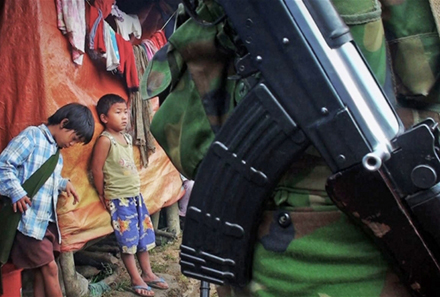2015 Myanmar/Burma Update: identity and ideas more powerful than resources in causing conflict.
Four different angles on Myanmar’s contemporary conflicts were on offer at the recent 2015 Myanmar/Burma Update, with speakers providing fresh insights into the roots of the Kachin conflict, the use of landmines in Burma, the role of gender in conflict, and the Pa-O-Self-Administrated Zone.
Questioning the view that conflict between the Kachin minority and the Burma military is primarily resource-driven, Dr Costas Laoutides and Dr Anthony Ware of Deakin University suggested that clashes over resources are a manifestation of deeper problems to do with identity.
Laoutides and Ware exposed powerful historical narratives as ideological roots of the conflict, gleaned from fieldwork interviews with key Kachin informants, including state officials and armed group members.
“Almost everybody spoke about feelings of discriminatory control of their culture,” said Laoutides and Ware.
Highlighting Kachin notions of “Burman chauvanism,” Laoutides reported that interviewees spoke of how the Bamar majority “tried to dominate and control us,” drawing attention to inequality and restrictions of the practice of culture as key grievances of the Kachin.
Needing permission to hold Kachin cultural festivals for example, contributes to a “big brother, little brother attitude,” Laotides explained. “The Kachin feel that they are treated as subjects, rather than equals, by the Burman majority.”
While vested economic interests certainly hamper the road to peace, Laoutides and Ware concluded that struggle over resources plays an instrumental role in a broader struggle based on competing outlooks of power management.
To make sense of the Kachin conflict we must go beyond an understandings of it as primarily “resource-driven.” Rather, the struggle over resources is a means for the Kachin to ensure their communal survival and expression of identity.
Gregory Cathcart of DanChurchAid spoke of an oft-overlooked aspect of Myanmar’s conflicts – land-mines. With recent figures putting casualties in Burma as third highest worldwide, after Afghanistan and Colombia, Cathcart complicated conventional understandings of land-mines in their use by community members as a form of protection.
“Land-mines have gone from military use only to ‘business mines’ used to protect economic assets, such as dams and gold mines,” said Cathcart. Land-mines can thus be understood as a community level response to conflict and outside threats, where community members are “active subjects, rather than victims”.
Examining the ongoing use of land-mines for protection despite their obvious lethality, Cathcart highlighted the associated risks as just one among multiple dangers to be managed by civilians in going about their lives.
“If we remove our land-mines our forests would be gone,” locals told Cathcart.
As for how the issue relates to the current ceasefire context, “it’s an issue for later” said Cathcart. “While there is ceasefire it is too early to clear mines that protect resources.”
Gender was also shown to play a major role in Myanmar’s conflicts. Jenny Hedström of Monash University examined women’s involvement in the Kachin armed resistance and the ways in which gender roles are “at the heart of ethnic nationalisms and therefore at the heart of ethnic conflicts.”
Women’s experiences of marginalisation, insecurity and discrimination based on gender mean that many women don’t have a voice when it comes to conflict. Women are systematically excluded from participating in high-level political activities, Hedström argued.
Key drivers for women’s participation in ethnic conflict are ideological, Hedström said, but are importantly linked to direct experiences of gender based oppression and violence. Women’s experiences of conflict are also defined by gender, such as traditional values forcing women to ‘stay home’ when they want to fight.
“I want to be a very brilliant fighter in combat, but as a woman I cannot go,” one interviewee told Hedström.
Finally, shedding light upon the Pa-O region in Southern Shan state – a conflict hotspot marred by ethnic tensions funded by the narcotics trade – Ricky Yue of City University, Hong Kong brought a “new understanding of warlord politics” to the discussion.
Yue reported an emergence of “new actors with new agendas” since 2010, with civil society coalitions presenting a powerful front against state power, while old actors have taken on new roles. Armed groups have formed civil society groups to create a new kind of warlord politics.
Fundamentally, ceasefire agreements are a “curse, a statecraft tool” serving only to maintain centralised power, Yue argued. Making sense of the contemporary Pa-O conflict, Yue suggests that in the region, “peaceful co-existence is an illusion”.
Yue concluded the discussion of Myanmar’s borderland conflicts on a note that harked back to Mary Callahan’s image of a “perfect-storm,” warning observers to manage expectations with regard to the tensions inherent in the peace process.
Amy Doffegnies and Cecile Medail are PhD scholars researching Myanmar at UNSW Canberra.
 Facebook
Facebook  Twitter
Twitter  Soundcloud
Soundcloud  Youtube
Youtube  Rss
Rss 